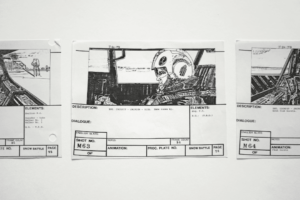When script writing, your script, also known as a screenplay, should detail character dialogue, scene settings, and actions that take place throughout a film, TV show, or another visual story. Your screenplay should properly tell your film’s entire story from start to finish because it’s a blueprint of the plot and character development before the film comes to life on screen.
Quentin Tarantino explains his writing process:
How to Write a Script
Writing a script helps express your creativity and make a story come to life. It often takes time and dedication to craft well-rounded characters and a compelling plot. These steps can help you create a captivating script:
1. Read other scripts
Download a few scripts or screenplays to find examples of well-written dialogue, characters, and storylines and to learn what producers are looking for in terms of genre conventions and themes. It might help to take a few writing workshops to develop your skills or better understand how to craft a strong script.
As a writer, you want to consider the production probability of actually selling the script:
- Realistic budgets. Although it may be fun to write a science fiction film with heavy visual effects, production design, and costumes, these elements make the film more expensive.
- Intellectual property infringement. For feature films, unless the property is public domain or bought by the writer, the writer should focus on creating an original story. In contrast to television scripts that might create spec scripts for existing shows, using franchises like Star Wars or Harry Potter for sample scripts could cause liability issues.
For story marketability, writers are typically encouraged not to follow market trends since by the time the script has been polished, the trend may no longer be popular.
In general, you should write what is interesting to you with a story that you are passionate about.
2. Build your world
Think about the location of your story. Detail your world well enough to help audience members vividly imagine it. Consider the genre of movie that you want to create. A few elements to consider in world-building are:
- Time period: Does your story take place in the past, present, or future? Though the script doesn’t have to mention an exact date, keep it in mind as you write.
- Weather and climate: Is it hot or freezing? How does the weather in this world affect your characters and the overall plot?
- Story themes: Determine your themes and what your audience should gain from this film. Do you want them to leave feeling happy, or do you want to convey messages that make people think deeply?
- Location: Where are your characters and where do they go? Abandoned houses, New York City, etc.
3. Develop your characters
Determine who your main character is and note their:
- Strengths
- Flaws
- Goals
- Obstacles keeping them from overcoming these goals
For other characters:
- How do they interact with the main character?
- Do they help your protagonist?
- Are they acting as an antagonist and keeping them from achieving these goals?
When building an antagonist, consider:
- What do they want from the main character?
- What does the main character want from them?
- Why does the antagonist want to keep your protagonist from achieving their goal?
4. Organize your story with a synopsis
A film synopsis outlines the story in the order that your audience will view it. The stages of your story typically include:
- An introduction to the main character and their world
- An inciting incident that gets the story moving
- The first turning point that presents the character with a new situation or challenge
- A call to action where the hero’s goal gets specific
- A point of no return when your protagonist risks or loses everything
- The all is lost point where the hero faces great danger and will have to rise to the occasion
- A second turning point where the stakes become higher as the character redeems themselves
- The climax when the story comes to a resolution
5. Write your first draft
As you build your first draft, follow your synopsis, and start building your story.
- Write out scenes that create conflicts and challenges for your character
- Create other scenes showing how they overcome them
Take risks while you write this first draft, and try to get your ideas out as best as you can. You can revisit these ideas later during your rewrite to see if they work well with your plot.
Consider writing a 1-2 sentence logline that summarizes the plot of your script so anyone can easily understand what the main ideas of your story are. Ex: the logline for A Quiet Place might be: “A family must live in dead silence so they can avoid monsters with incredible hearing abilities”
5.1. Formatting Elements to Include in a Script

Above is a great source from Writers Store that shows the basic formatting need in a script.
Many cinema production programs teach students how to properly format scripts so that filmmakers, actors, and production crew members can easily read it. Since production companies receive new scripts every day, they may disregard a script that’s not properly formatted.
You can either format the script yourself or use a scriptwriting software like Final Draft, WriterDuet, or Amazon Storywriter that automatically formats it for you. Here are some elements to include:
- One and one and a half-inch margins: The right, bottom, and top margins should all be one inch. Additionally, your left margin should be 1.5 inches to leave plenty of space to bind your script.
- Fade in/fade out: In the upper right-hand corner, your script should always start with “Fade in:” to signify the beginning of the film. The end of the script should have the words “fade out” or “fade to black.”
- Scene heading: Also known as a slugline, write the time of day and scene location in capital letters, like “EXT. LILLY’S HOUSE – DAY” or “INT. GROCERY STORE – NIGHT.”
- Action lines: Using present tense, include brief visual descriptions of physical actions occurring in a scene. An example could be, “Jane’s phone buzzes. She picks it up to find a message from John.”
- Character dialogue: The names of your characters should be in uppercase letters and centered to identify the person speaking. Place the character’s lines underneath their name in the script, also centered.
- Parenthetical: If a character has a specific mood or action while speaking, include a parenthetical phrase under their name, above the line. For instance, to show the seriousness of a character, you can write “(straight-faced).”
- Extension: This is a parenthetical direction used for character dialogue that is off-screen. For characters who are in-scene but talking off-screen, use “(O.S.).” For character dialogue that only the audience hears, use “(V.O.)” for voice over.
- Mores and Continueds: Use (MORE) and (CONT’D) between pages to show the same character is speaking
- Transition: Film editing instructions like CUT TO, DISSOLVE TO, SMASH CUT, QUICK CUT, FADE TO (only for production scripts)
- Shot: Used when the scene has changed like ANGLE ON, EXTREME CLOSE UP, PAN TO, POV (only for production scripts)
- Intercut: Cut instructions between scene locations
Here is more video detailing the basic elements to format a screenplay:
Length of a Script
There are many different types of scripts, so the length depends on what genre and visual storytelling project it’s for. As a general estimate, one page of a properly formatted script equals one minute of screen time. Many scriptwriters use 12-point Courier font for proper formatting and to more accurately estimate the length of the production.
Here are the typical length estimates for a variety of visual storytelling projects and genres:
- Feature film, drama: 100 to 120 pages
- Feature film, comedy: 90 to 100 pages
- Animated films: 90 to 100 pages
- Television, comedy: 25 to 35 pages
- Television, drama: 45 to 55
- Short film: Varies depending on the story, up to 60 pages
6. Reread the first draft
Reread your script and cut any parts that seem irrelevant to the overall story. It can help to print the script out and highlight or mark sections to address in the rewrite. Make note of sections that have:
- Irrelevant dialogue or weak plot points that don’t push your story forward or directly affect your protagonist achieving their goals
- Confusing scenes that need extra clarification
- Information that requires more research or fact-checking
- Long monologues you can shorten to be more to the point
7. Rewrite your script
Scripts usually need a few revisions before you’re ready to send them to a potential buyer. Each action should push the story forward. Continue rewriting until you accomplish this. Make sure your rewrites are addressing:
- Plot holes: Correct any errors that go against the logic within your plot. Rid your story of any contradictions or inconsistencies that make your story less credible.
- Character motivations: Everything a character says or does should have a reason behind it that fits their personality, needs, and goals. If their words or actions aren’t motivated by their needs or goals, you may need to rewrite or cut them.
- Adding or cutting scenes: While reviewing your marks, start cutting scenes irrelevant to the plot and add new ones that strengthen your story. With each line and scene, ask yourself what would happen to the story if you cut it. If the story works without it, it may be best to cut it and add stronger elements that drive your plot.
Scriptwriting takes a significant amount of time, discipline, and motivation. By understanding what a strong script looks like and knowing how to outline your story properly, you can feel more confident in your ability to start and finish a strong script.
You can learn all skills related to film making by applying to the Nashville Film Institute here.















